While road car tyres have gradually grown in width and reduced in sidewall height, Formula 1 doggedly stuck to its 13-inch wheel sizes for decades, chiefly for political and economic reasons.
That will end next year as the sport switches to a new 18-inch format. The change coincides with F1’s introduction of drastic new technical regulations intended to improve the quality of racing. It is, therefore, of paramount importance that Pirelli’s all-new product delivers.The history of F1 tyre sizes and aspect ratios – the relationship between sidewall height and contact patch width expressed as a percentage – is as complex as it is convoluted.
Rewind to 1985: Goodyear enjoyed an effective monopoly on 13-inch tyres that extended – sporadic competition from Pirelli aside – until 1996. The US brand saw no reason to follow road car trends simply to beat itself.
Then along came Bridgestone in 1997 and suggested lower profiles, only to be rebuffed by a Goodyear afraid of losing its advantage. Two years later Goodyear departed, and Bridgestone – now the de facto sole supplier – applied the same arguments when Michelin entered F1 in 2001. After the French company departed six years later Bridgestone was awarded the first official FIA sole tyre supplier contract, and simply carried over its rubber through to the end of 2010.
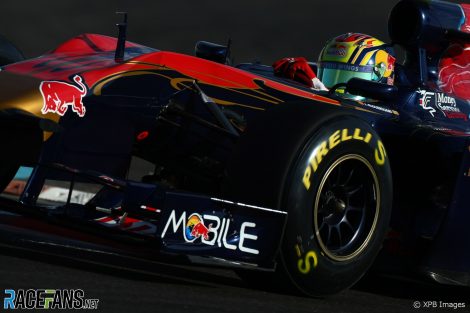
F1’s ‘new era’ tender, however, specified 18-inch rims with reduced aspect tyre ratios – seven years after WEC and Formula E (and other series) switched to low profile tyres. Pirelli and Hankook applied for the F1 deal, the former winning an extension of its contract.
The wheel sizes formed an integral part of F1’s overhaul of its technical regulations package which was planned for 2021, but delayed by a year due to Covid-19. This afforded Pirelli useful additional development time. Track testing was, though, placed on the backburner due to costs and the 2020’s punishing schedule – 17 rounds in 160 days – and Pirelli’s contract extended a year.
The decision to move to low profiles had, though, been taken “five or six years ago in the interests of modernity and (road) relevance” a source with knowledge of the process told RaceFans, but delayed until a revised technical package was introduced as teams had been promised regulatory stability until end-2020.
Advert | Become a RaceFans supporter and
Apart from aesthetics, the advantages of larger rims and lower sidewall heights include more direct response to steering and braking input, greater control over spring rates as the ‘jounce’ of high sidewalls is reduces, and increased brake disc area and therefore potentially improved stopping power – in turn facilitating ceramic (or other) braking technologies as F1 strives to phase out carbon friction materials.
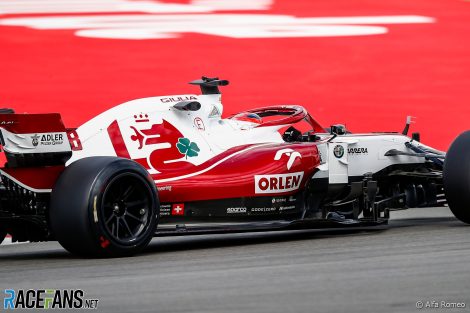
During initial technical discussions between all teams, FIA, F1 and Pirelli it was agreed that tyre diameter would increase marginally, from 660mm to 720mm, with rims incorporating fixed wheel covers and finger recesses. The latter are intended to help mechanics carry the heavier wheels during pit stops. Covers displaying graphics were considered but pushed back, potentially to 2023.
Mario Isola, Pirelli’s head of car racing, says they requested information from teams on expected levels of downforce [and resultant g-forces], details on engine torque and power outputs and anticipated maximum speeds. Once the data had been verified – he smiles as he recalls “crazy figures” provided during a similar exercise in 2016 – Pirelli prepared the first finite element models to design ‘virtual’ 18-inch tyres.
“Heat transfer is an important parameter because the spacing between the brakes and the rim is much higher,” Isola explains. “Therefore we predict there will a lot less heat transfer from the brakes,” in turn affecting tyre warm-up.
“We supplied two different models for simulation purposes – a finite element model [FEM] and a thermal mechanical model of the tyre which is what teams use in their simulators, including driver-in-the-loop simulators.”
Pirelli’s FEM data is encrypted. “We are the owner of the model and only we know what’s inside, but we update it periodically depending on feedback we get from the teams. Sometimes you get feedback from teams that is quite different, so they adjust their simulations or we adjust our model depending on the situation.”
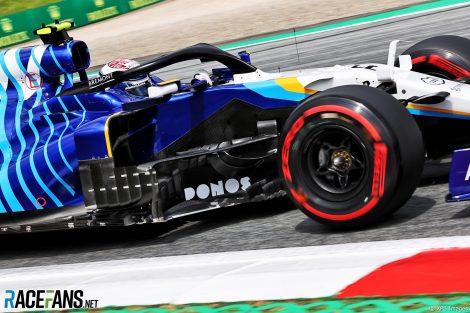
“[F1] enabled us to develop new techniques,” says Pirelli’s research and development chief Pierangelo Misani. “If you need tyres that are light with less material than the standard one you have to reduce tolerances. So, I can say the experience [obtained] in Formula 1 is not purely related to materials, it is not purely related to geometry, it is not purely related to performance, but also to development tools and methods, and manufacturing processes.”
Misani adds that the [shape] of the tyre is fundamental. “It determines how the tyre will generate forces, because it’s how you put the contact patch on the ground and how the forces that are generated are transmitted to the rim, then to the car. The final profile is crucial to the process as it dictates the moulds that are required for batch production of the prototype tyres used for both laboratory and track testing.”
In other words, get it wrong and its back to square one, whereas materials used for actual carcass construction and compound ingredients can be fine-tuned later.
Advert | Become a RaceFans supporter and
“To validate the profile, we asked – and [FIA, F1 and the teams] agreed – to start testing in September 2019.” This was done with ‘mule’ cars, adapted from 2018 cars to replicate ride height, downforce and car mass. “That way we had the possibility to freeze the profile, then to start focusing on construction and compounds in 2020.”
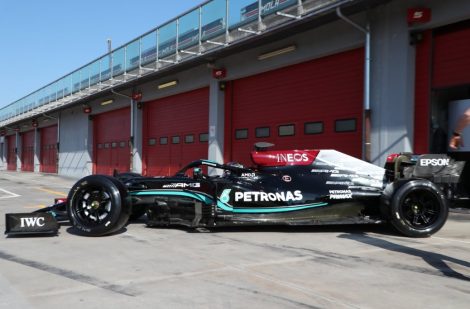
In the interim Pirelli continued its indoor test programme at its Milan R&D base using tyres produced in batches of 10 by its F1 plant in Slatina, Romania and trucked to Italy. (Pirelli has replicated its F1 production line at its Izmit, Turkey facility – per chance situated 20km from the site of last Sunday’s grand prix – lest the Romanian plant be hit by natural, or other, disasters.)
Once F1 was back on track, testing resumed with nine of the ten teams committing their participation. Williams declined as it was in the thick of its sale process to Dorilton Capital when agreement for this costly exercise was required.
Underlining the importance of the coming change, even world champion Lewis Hamilton, who usually shuns testing, offered his services at Imola after this year’s Emilia Romagna Grand Prix.
“I don’t ever volunteer for test days and it’s probably one of the first ones that I have volunteered for,” he said afterwards, adding with a smile, “So I immediately regretted it when I woke up in the morning on the day! I was like ‘damn it!’.
“It was at a really great track to test at so I enjoyed the day and the weather was good. I plan to be [in F1] next year and want to be a part of it, I want to help Pirelli towards having a better product.
“It’s important for me to gauge what the starting point is and what differences I can help with, so that from a driver point of view we have more mechanical grip from the tyres, less degradation. It was a good test, and obviously it was the first step of the tyres, but it definitely wasn’t a bad place to start.”
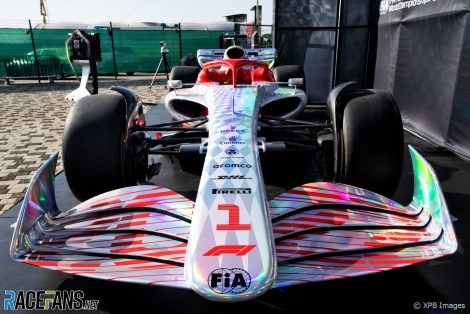
All tests across Pirelli’s prototype dry, intermediate and wet tyre ranges have been completed aside from a final one-day ‘wet’ test at Paul Ricard with Alpine next Monday. As part of the programme all tyre-specific data was shared with teams, and updated on an as-and-when basis. All teams bar Williams – which did not build a ‘mule’ – will attend a composite two-day test in Abu Dhabi after this year’s finale.
“We’ve had feedback lap times and basic information from each test, with technical bulletins coming through from Pirelli,” confirms AlphaTauri technical director Jody Egginton. “We’ve done a lot of simulation work with the model [of] the tyre, so we understand what it’s going to do, we’ve got a good grip in vehicle dynamics terms.”
However, he makes a point about a hefty elephant lurking in a corner of the design office: “We’ve got a big increase in tyre and wheel mass, plus we’re not allowed to run (mass damping) inerters [from next year].”
Isola says car mass will increase by 14 kilograms due to the heavier wheel and rim assemblies, split roughly 3kg per front wheel and 4kg for rears. Simply put, there’s more heavier alloy metal and less lighter tyre rubber, hence an undesirable increase in un-sprung weight. Add in the fact sophisticated suspension systems are banned from 2022 and the extent of next year’s re-engineering challenge becomes clear.
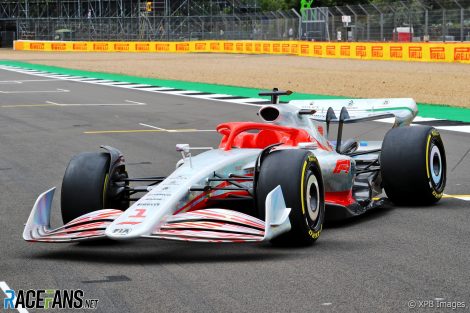
The wind tunnel models, produced in a dedicated studio in Rome, are a major contributor as tyres constitute a third of frontal area while spinning at enormous speeds. The resultant wake affects airflow across the entire car, while steered wheels deform in compression, yaw, and pitch, causing sidewalls and contact patches to constantly change shape. An aerodynamicist’s nightmare, in other words, unless these mini-tyres are spot on.
For teams the biggest challenge is yet to come: translating tyre test data into on-track performance. Ferrari racing director Laurent Mekies says the 2022 F1 season brings “three massive pillars that are completely new: completely different aerodynamic regulations, different ways to operate the car (due to revised sporting regulations) and mechanical suspension, which nobody has had for 10 or 15 years.
“So a lot of different limitations. And in the middle of those, how to ‘switch on’ the completely new tyres. I think that’s going to be the big challenge. There will be a huge amount of discovery with the 18-inch [wheels]. It’s a great challenge as a team to make sure we have the base to get the core understanding we need.
“There will be a very steep learning curve, but in two years we will look back at the starting point and wonder what we were doing at the time…”
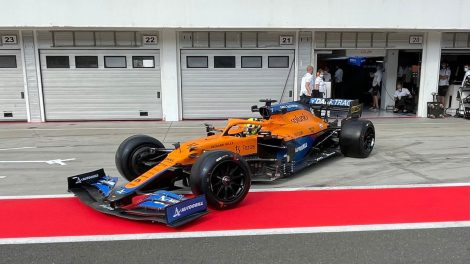
“I think it will be a combination of the concepts, the new regulations, how they interact with the tyres and how you make everything work. I think we have the potential to see a surprise also from midfield teams. It’s risk and opportunity for everybody.”
All parties agree that the level of research that has gone into the 2022 regulations by far exceeds what has gone before – whether at FIA, F1 or team levels – while Pirelli has been afforded longer development times than at any previous stage in its 10-year F1 history; indeed, longer than any tyre supplier has previously been afforded, with the pandemic further opening the window.
That is how crucial the bigger black roundels that adorn each corner of a 2022 grand prix car are to the future of the sport. Not only are they the single biggest visual indicator of F1’s ‘new era’, but the biggest single advance in F1 tyre technology since the sport adopted radial ply tyres in the seventies; possible even more so. Pirelli must not screw up, and Isola and his team knows it.
RacingLines
- The year of sprints, ‘the show’ – and rising stock: A political review of the 2021 F1 season
- The problems of perception the FIA must address after the Abu Dhabi row
- Why the budget cap could be F1’s next battleground between Mercedes and Red Bull
- Todt defied expectations as president – now he plans to “disappear” from FIA
- Sir Frank Williams: A personal appreciation of a true racer




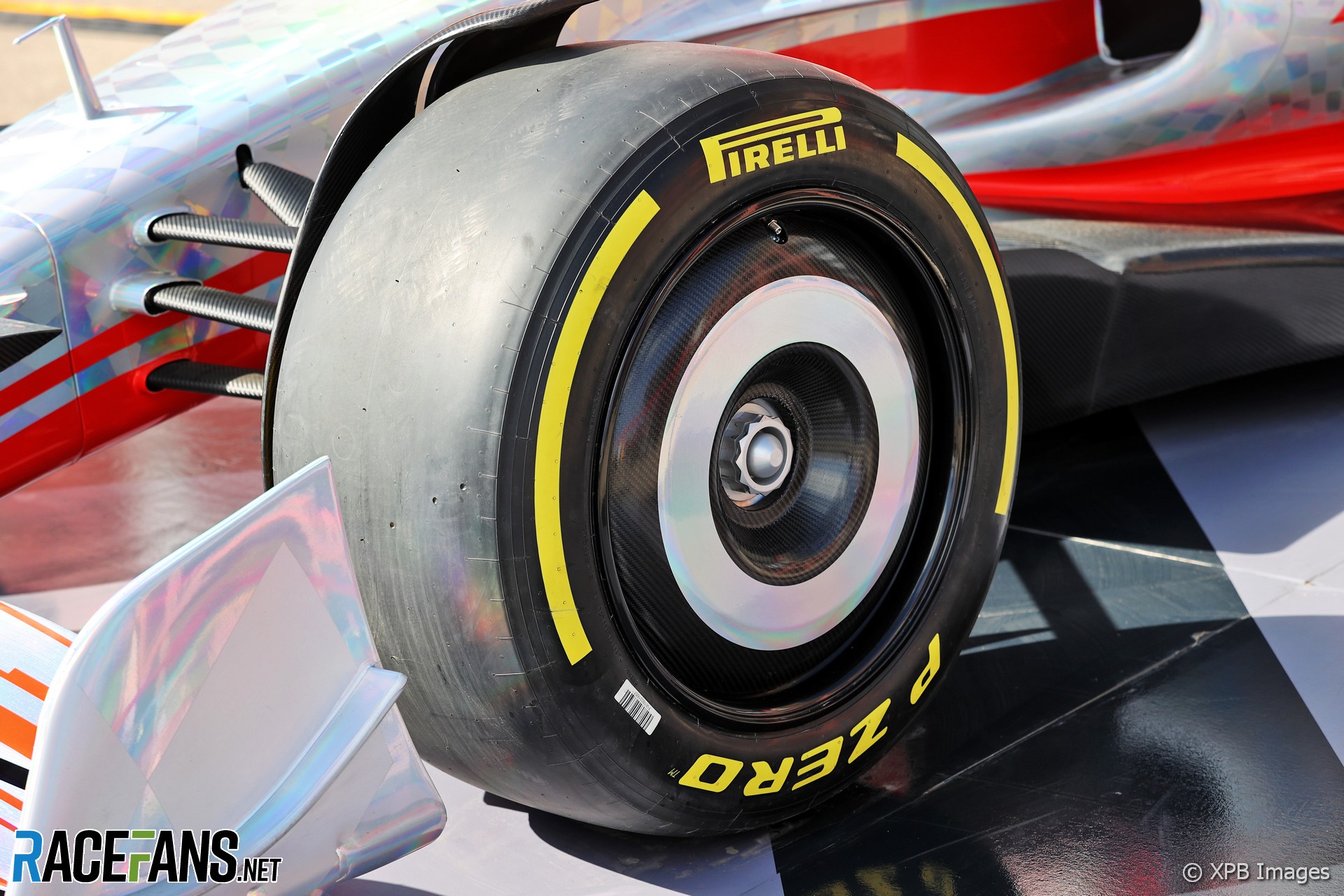
Mashiat (@mashiat)
13th October 2021, 12:31
What I’m not entirely sure of is what road relevance has to do with F1 tyres? Last I checked, I’ve never seen any slick tyres on road cars before. Will Pirelli really learn anything from this? Unless they want design-to-degrade road tyres as well to spice up the trip to work.
Dieter Rencken (@dieterrencken)
13th October 2021, 12:34
Have you read the piece?
Mashiat (@mashiat)
13th October 2021, 12:42
@dieterrencken I understand that Pirelli says F1 has enabled them to improve manufacturing efficiency and so on but is that relevant to whether it’s 13 or 18-inch rims?
MacLeod (@macleod)
13th October 2021, 13:05
Current (and future) road cars having more and more wider chassis and lower tyre walls so F1 should follow that trend the current tyre of F1 are old ways of doing things the newer tyres have just beter driving abilities then the old one. So 18″rims old style will create huge ballons (think of the 70s) so 18″ with lower sidewalls keep those more current.
anon
13th October 2021, 13:24
Still, the point is valid – having spoken to an individual who was working in that sector, he actually felt that it was far simpler to produce a race car tyre than a road car tyre and that there really was very little relevant overlap between the technical requirements of road and race tyres.
Robbie (@robbie)
13th October 2021, 16:40
anon I find that really hard to believe as one would think the demands of road cars have remained fairly stable and therefore pretty easy by now to predict and build for, whereas loads via downforce, cornering speeds, torque upon acceleration, and forces under braking have to be considered every season with the cars’ changes in F1, especially when combining those forces with getting the tires to degrade a certain way.
anon
13th October 2021, 20:49
@robbie the range of parameters which you have to take into consideration are actually much smaller in racing than you have to consider for a production vehicle.
For a racecar, your primary objective is geared about producing peak performance over what, when you consider it objectively, is a very short operating lifespan. Those items you list don’t actually make it as difficult as you might consider, because ultimately they all tie back into the same thing that you are trying to achieve – just getting that peak performance for a relatively short duration, with pretty much everything else being of pretty minor interest by comparison.
By contrast, a tyre that you have to produce for the public has to consider a lot more parameters – the range of operating temperatures for a road car are much more variable, whereas most racecar tyres can be optimised for a much narrower operating range, and you have to deal with a far wider range of weather conditions than any racecar is likely to ever face. Road surfacing materials and standards of construction are also vastly more variable on public roads compared to motorsport surfaces too.
Practical lifespans are, quite literally, orders of magnitude apart, and motorsport hasn’t really cared about producing an economical product in the way that road cars have to consider. That is before you get onto legislative requirements and consumer requirements – for example, noise emissions from tyres is not an issue in motorsport, but is a practical concern for a road car – or the balancing act of trading off grip versus rolling resistance and its impact on fuel economy, or issues such as the correct balance to strike on the compliance of the tyre and the impact that has on driver and passenger comfort.
In practice, the constraints which you have to face – the ones I’ve listed above are just a sample of some of the issues – for a road car tyre are more extensive, as there are many issues that motorsport does not, and likely never will, care about that you do have to consider when selling a consumer product.
Robbie (@robbie)
14th October 2021, 15:26
anon I am no expert on tires, but somehow your argument doesn’t ring true for me. It seems based mainly on the premise that because race tire makers have to only consider a tire’s performance for short lifespans they are easier to make. I would argue that the forces and temperatures on road cars have remained similar for years and years. There isn’t such variety in pavements that it is complicated to figure out traction vs fuel economy vs road noise vs rolling resistance. I’m quite confident that I could take my car and drive all around North America and not have a single issue with traction on any roadway, winter conditions aside, and there are tires for that. On the other hand race cars change every year as do therefore the demands on the tires. I’m not saying I don’t think they are always refining road tires, but I think they have had the gist of the idea for quite a long time.
anon
15th October 2021, 8:31
@robbie the point about the lifespan is that those same tyre manufacturers can afford to trade off other factors that, for a road car, would not be tolerated by the end user, or can afford to ignore factors that are completely irrelevant to motorsport that cannot be ignored for the public.
You keep harping on about “oh, racecars change every year, so it must be harder” – but it really doesn’t make as much difference as you seem to think, whilst the factors you seem to think are so trivial in the non-motorsport world really aren’t as simple as you seem to think they are.
Fine, if you want to keep projecting motorsport as this sort of exceptionalist beacon, go ahead – it really isn’t and it’s more PR than fact, but if it makes you happy, then go ahead.
Dieter Rencken (@dieterrencken)
13th October 2021, 14:07
It’s relevant to the design, development and construction processes of an entirely new range of tyres, including compounds and tread patterns for whatever applications, regardless of what some may ‘feel’.
Zann (@zann)
13th October 2021, 14:52
The relevance is to how it’s worthwhile for Pirelli to do F1 @mashiat – selling their road tyres. Now the F1 tyres will at least look faintly the same shape as what they’re trying to sell.
TSmith
13th October 2021, 16:33
Do you think road relevance begins and ends with tread patterns? And that tire construction methods, sidewall construction designs, rubber compounds, steel vs composite belting, etc. make no difference?
NS Biker (@rekibsn)
13th October 2021, 17:18
Likely the only realistic “Road Relevance” between F1 tyres and what the general public (and OEMs) buy, is that they are round, black and have a distinctive odor when new.
On the consumer side, it usually comes down to price. Advertising can add some elasticity to the price equation, but building a comfortable, decent performing, looong lasting, robust and cheap tire for the unwashed masses (and yes, that includes me) likely takes very little from the technology development in F1.
S
13th October 2021, 12:49
It doesn’t really matter if the tyres are objectively good or not. There will always be a bunch of people who will bag out Pirelli just because they have this fanciful idea that some other tyre manufacturer can walk straight in and do it better.
Rather than focusing on tyres F1 should be concentrating on making better cars, as they harm the on-track product far more than any tyre can. I’d even go so far as to say that not just the current cars and their performance demands, but F1’s constant fascination for breaking speed records are the primary reasons that Pirelli appear to have something less than perfect in F1 now. Those demands are impossible for any supplier to meet.
Robbie (@robbie)
13th October 2021, 15:43
I don’t think it is ‘fanciful’ thinking that has many convinced another tire maker could do it better. Or at least differently. It depends on F1’s mandate though, and then how the tire maker takes said mandate and runs with it. My understanding is that while Pirelli was mandated to make degrady tires, they weren’t necessarily mandated to make them degrade the way they do. So of course Pirelli and several other makers could make tires better, but define better in relation to what F1 is looking for. Of course they can make them last a race distance if that is what is desired. Or they can make them degrade from tread wear while being far less sensitive to temps, rather than as they are now, so sensitive to temps. Anyway, the new tires will I’m sure be quite different, or otherwise left behaving as they do now, that would fly in the face of what they are trying to accomplish with the new cars, that being to race closely.
“Rather than focusing on tyres F1 should be concentrating on making better cars…” Said like they haven’t been planning for better cars for 5 years and are about to introduce them next year. As well, I’m quite sure they can focus on tires and better cars at the same time. Indeed, what better time?
I don’t think F1 has a constant fascination for breaking speed records, nor that if they did that would be a reason for Pirelli appearing to have something less than perfect, nor that the demands F1 makes are impossible for any supplier to meet. Pirelli and other makers could relatively easily make proper racing tires that drivers can push for a greater percentage of a stint while not being so finicky temps wise. Anyway, next year there will be less wake and the cars far less sensitive to what dirty air there is, and so there shouldn’t nearly be the detriment to the performance of the car due to the front end moving around in dirty air, than there is now. So even if they were to retain the same compounds with the same characteristics, which I doubt they are, they would likely do better on next years cars. But they should be sturdier than that, I expect.
Dan
14th October 2021, 7:44
Personally I have never liked the emphasis on tyres, even though it’s a great subject to debate.
I sometimes ask myself as an idealist, why not dispense with razor blades which are part of the aero design, contacting these rubber dildos(balloons), usually ruining half the races within the first few laps so, zzzzzz
Why can’t we just get rid of the former, and if tyre companies were as good as f1 needs them to be, just have them constructed so they are not reliant on air ?
I can see u huge passenger car benefit from that.
BasCB (@bascb)
13th October 2021, 13:05
Well, I certainly hope they have nailed the development of the tyres and we won’t see any blowups etc nor get too many inconsistent tyre behaviour with the new cars.
Bosco Moroz
13th October 2021, 15:33
In my opinion, the stress will be moved over to the suspension, now that the tires themselves will no longer be a suspension part. I see many cars hitting kurbs, then a spectacular failure and into the wall. Also gonna miss those slowmo’s of the tires flexing over the kurbs. Can’t wait to see what happens at the Wall of Champions in Canada, or
the chicane in Hungary. How will they attack high kurbs? Will F1 be making mid weekend track changes after early carnage.
Maybe they have it figured out…
I hope it will be the positive we can only dream of, where they can push hard all race and the tires just work. No crazy warm up and cool down, get the tire into the perfect working range BS…. That is one area they figured out in Indycar.
Now a prayer to the F1 Gods – Please don’t make us wait 7 years for another competitive season.
frood19 (@frood19)
14th October 2021, 7:15
I don’t know if we will see failures but it will be a new way of driving certainly. I recall in the late 90s and early 2000s many a spectacular still image of cars getting thrown into the air over the kerbs at places like Monza (especially the old rettifilio) and the nurburgring (at the veedol chicane). The violence with which the cars bounced around was supposedly one of the reasons Schumacher didn’t return sooner in 1999 following his broken leg.
I’m curious to see what these changes will bring. It certainly seems to be a potential banana skin for a big team to get disastrously wing. My worry is the increase in mechanical grip and braking power will result in even shorter braking zones than we have now.
Balue (@balue)
13th October 2021, 17:10
Good article. About the fixed wheel covers, that was tried before and dropped because it looked ridiculous. I can’t see it doing better this time around.
Mr David Dewis (@davehaslanded)
13th October 2021, 22:33
They were talking about putting LED dipsplay panels on them previously, showing race position etc. but I’ve seen nothing about it in a while. So not sure if it’s happening.
Balue (@balue)
14th October 2021, 7:04
@davehaslanded *shudder*
Yaru (@yaru)
13th October 2021, 23:36
I’ll be honest the comments section technical read for this article has been great. I really thought 95% of it would be “Pirella sucks, go away already”.
Sensord4notbeingafanboi (@peartree)
14th October 2021, 3:24
I seriously doubt the 2022 tyres are indeed going to be beyond reproach as I don’t buy into the degrade for show claim. I don’t believe Pirelli would, even if asked, produce a bad tyre on purpose. The inters are good, I’m sure they would rather have all compounds work like that. The f2 tyres are not great, better than the 13 inch. I reckon they are only better because they are less tyre. Less tyre less for pirelli to compromise.
S
14th October 2021, 11:06
The F2 tyres have vastly different demands placed on them. Not really comparable.
No matter what Pirelli (or any other tyre manufacturer) produce for F1, the teams will treat it in such a way as to make it look ‘bad’ anyway.
Almost any tyre can be seen as good or bad, depending on the design targets are placed on it and the conditions it operates in.
Sensord4notbeingafanboi (@peartree)
14th October 2021, 12:13
S, the f2 cars are different, much less demanding, but they are the same tyre.
Nealio
14th October 2021, 16:52
If any tire was ever “designed” for commercial reasons it’s the new 18″ tire! The combination of greater weigh, reduced compliance and increased width in combination with the new simply mechanical suspensions add up the less performance, not more. You can’t cheat Physics.
NS Biker (@rekibsn)
15th October 2021, 1:31
From L. Mekies, “and mechanical suspension, which nobody has had for 10 or 15 years.”
This brings up an interesting issue. Effectively the current cars rely on the tyres for much of the suspension and titanium rub blocks under the car to protect the expensive bits that would otherwise run on the track.
Without the large sidewall tyres, limited design options for suspension and a new ground effects down-force generator that is very ride height dependent, it is going to be interesting to see how the teams, drivers and designers address all of this.
Likely we will see lots of sparks flying.
I have an opinion
15th October 2021, 2:49
In answer to Dieter’s question, yes, slower tyres must produce closer racing.
As the possible speed of a tyre decreases towards zero, the possible speed difference between teams using the same tyre will also decrease towards zero.
And we know the bigger wheels / tyres will be slower, because F1 engineer James Allison told us so on this website.
As many commenters have rightly pointed out, the switch to 18-inch wheels is purely for marketing.
reg (@reg)
15th October 2021, 5:47
It will be interesting to see if a flat tire incident will be more survivable for getting back to the pits versus the current tire failures that can really destroy body work. For instance, LeMans prototypes seem to be able to limp their way back to the pits a lot more safely on a flat, and I would think the large rims are a partial contributor.